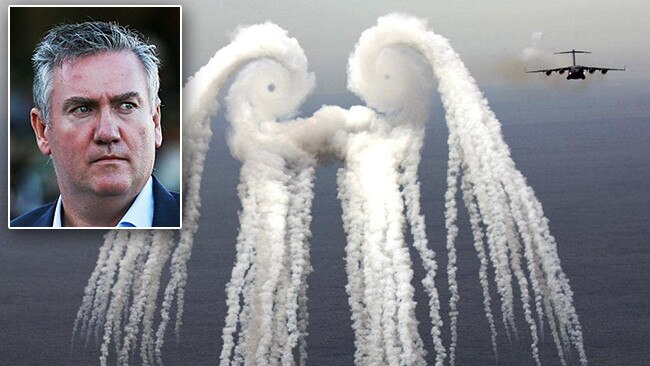Wake turbulence suspected in Qantas jet’s sudden dive
Eddie McGuire describes 10-second nosedive that terrified passengers after Qantas flight struck wake turbulence.

A “terrifying” mid-air incident involving two Qantas A380 jets this week forced one of the aircraft into a 10-second “nosedive”, in which passengers held hands believing they were about to die.
The plunge above the Pacific Ocean, about two hours into QF94 from Los Angeles to Melbourne, was believed to have been caused by the vortex, or “wake turbulence”, generated by another A380, QF12, which was flying from Los Angeles to Sydney and took off two minutes before QF94.

Qantas did not report the incident to the Australian Transport Safety Bureau, but after questions from The Australian, the safety watchdog last night sought an explanation from the airline and promised to review the response.
Among the passengers was Channel 9 star Eddie McGuire, who spoke this morning of the on-board scare.
“Somebody described it as the feeling of going over the top of a rollercoaster, slightly, not the fall — just a little, ‘what’s going on there?’. There was a little bit of turning of the plane as well and a little bit of downward,” he said on his Triple M radio show.
“It was one of those ones that got your attention. Then it levelled off.”
Fellow QF94 passenger Janelle Wilson said the “three-quarters-full” plane, with a seat capacity of 484, suddenly entered a “free fall nosedive … a direct decline towards the ocean” for about 10 seconds.
“It was between 1½ and two hours after we left LA and all of a sudden the plane went through a violent turbulence and then completely up-ended and we were nosediving,” Ms Wilson told The Australian yesterday.
“We were all lifted from our seats immediately and we were in a free fall. It was that feeling like when you are at the top of a rollercoaster and you’ve just gone over the edge of the peak and you start heading down.
“It was an absolute sense of losing your stomach and that we were nosediving. The lady sitting next to me and I screamed and held hands and just waited but thought with absolute certainty that we were going to crash. It was terrifying.”
Flight track details show QF12 took off from Los Angeles at 11.27pm Sunday night (US time), 57 minutes behind schedule. QF94, which departed at 11.29pm, 49 minutes late, landed safely but 30 minutes late in Melbourne at 8am on Tuesday.
While Qantas said no one was injured and no damage sustained, the incident traumatised some passengers. It is the latest in a string of mid-air scares potentially linked to the wake turbulence of the giant A380s.
Aviation consultant and experienced pilot Byron Bailey last night called for a review of standards that are meant to safely separate A380s from other aircraft. “It’s a serious problem — they are going to have to really think about this,” Captain Bailey said.
An ATSB spokesman said: “Following our correspondence, the ATSB has made inquiries with the operator (Qantas) and they are voluntarily submitting a notification. Once received, we will review the information to determine whether any further action is required.”
Qantas suggested there had been no breach of separation standards, as the two A380 aircraft were understood to be apart by 20 nautical miles and 1000 feet in altitude.
“We understand that any sudden turbulence can be a jolt for passengers but aircraft are designed to handle it safely,” said Qantas fleet safety captain Debbie Slade. “As the captain explained to passengers at the time, this A380 experienced a short burst of wake turbulence from another A380 flying ahead and above it.”
Ms Wilson said Qantas staff on the flight described it as the worst incident they had experienced on an aircraft.
“Everyone was pulled up from their seats by the ferocity of it; it happened so quickly with no notice and just shocked everyone,” she said. “There were glasses, plates, bottles that were all smashed at the back of the plane.”
Ms Wilson said that, once the plane was stabilised, the captain addressed the passengers.
“He said we had been caught in a vortex due to the A380 Qantas flight on its way to Sydney ahead of us and that they were contacting air traffic control to request an alternative route,” she said.
“There were three flights we knew of that were leaving from LA to Sydney, Melbourne and Brisbane (within close proximity) and we were delayed by just under an hour, so I don’t know whether that played a part in it.
“We thought ‘how do two Qantas flights get so close?’ There was a lot of anger and curiosity after we all recovered from what was clearly a terrifying incident.”
Ms Wilson said it was fortunate dinner had just finished, with most passengers still wearing seatbelts.
Last year, Germany’s Federal Bureau of Aircraft Accident Investigation called for an urgent review of aircraft separation standards after a near disaster when a private jet was hit by wake turbulence from a Sydney-bound Emirates A380 above the Arabian Sea.
Wake turbulence was also blamed for the near-stall of a Qantas 747 flight from Melbourne, about 110km from Hong Kong, in April last year. ATSB’s investigation into that incident, in which 15 passengers were injured, was “nearing completion”.
Captain Bailey said that, from the witness descriptions, it appeared as though QF94 lost autopilot control after being hit by the wake turbulence and was momentarily uncontrolled. “It’s possible that the autopilot exceeded the breakout threshold and has disconnected,” he said.
Captain Bailey said Qantas might need to adopt a different approach to separating A380s on the busy Los Angeles route. “It might be a smart move to stay with the airway but to have each aircraft flying staggered, two to three miles off the centre line,” he said.



To join the conversation, please log in. Don't have an account? Register
Join the conversation, you are commenting as Logout